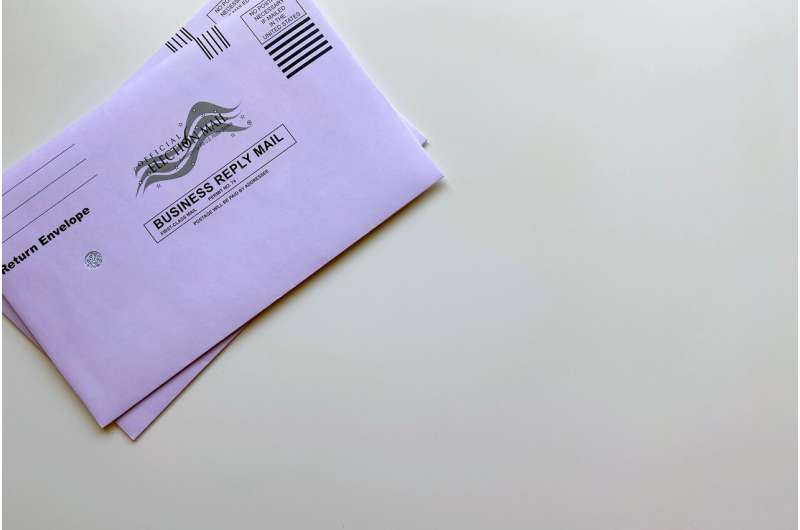This article has been reviewed according to Science X's editorial process and policies. Editors have highlighted the following attributes while ensuring the content's credibility:
fact-checked
peer-reviewed publication
trusted source
proofread
How the Meta algorithm influences election advertising

An LMU study reveals how Facebook and Instagram deliver political advertising. The algorithms seem to favor the contents of certain parties.
In the run-up to polling day, election campaigns go into overdrive. Streetlights and grass verges are covered with posters, while leading candidates dash from one talk show to the next. And then of course there is the internet, which has long become an arena for the election ads of all parties.
"With around 4.6 billion users globally, social media platforms such as Facebook, Instagram, and Twitter/X have become important tools for political campaigning worldwide," says Professor Stefan Feuerriegel, head of the Institute of Artificial Intelligence (AI) in Management at LMU.
Feuerriegel is the leader of a large-scale study, the results of which have recently been published in the journal PNAS Nexus. Investigating inequalities in online campaigning, the researchers discovered significant discrepancies in the cost effectiveness of advertising and the degree to which ads reached their intended targets. "We see clear systematic bias in how the political ads of different parties are delivered," says Feuerriegel.
In contrast to posters, public speeches, and TV ads, which are highly regulated, online campaigning does not reach all people equally. An essential feature of advertising on social media is targeting, which allows advertisers to select specific user groups and deliver tailored political messages to them. In this way, they can ensure that their content resonates with the political perspectives of the targeted group.
Is election advertising on social media fair?
What is dubious enough in non-political advertising is concerning in the case of political advertising. "If parties target ads at a specific audience or send contradictory messages on political issues to different target groups, this can limit the political participation of disadvantaged groups," says Feuerriegel.
What is worse, the algorithms employed by the platforms are beyond societal scrutiny. It is hardly possible to verify whether they lead to biases in ad delivery. "If, for example, some parties consistently pay higher prices than others for similar ads, this harms political competition," he adds.
It is no wonder, then, that targeted political advertising on social media has engendered serious misgivings among political actors, researchers, and society at large. Calls are getting louder to improve the monitoring of this form of election advertising in order to safeguard democratic integrity. Public pressure and regulatory efforts (e.g., the Digital Services Act in the EU) have pushed social media platforms to provide public access to political and social advertisements, allowing researchers to study them at scale.
For the new study, the team analyzed political targeting on Facebook and Instagram. Their dataset comprised over 80,000 political ads relating to the election campaign for the German federal parliament in 2021. The ads were placed by parties from across the entire political spectrum and generated more than 1.1 billion impressions.
"Our dataset provides a unique view of the targeting strategies that parties use across the entire political spectrum, during an election with more than 60 million eligible voters," says Feuerriegel's doctoral candidate and lead author of the study, Dominik Bär.
Algorithm rewards populism and reinforces stereotypes
Using this data, the researchers investigated to what degree the parties used targeting and to what extent the costs varied for the advertising (impressions per euro spent). "We find that targeted ads are prevalent across the entire political spectrum," says Bär. "In the run-up to the election, over 70 percent of all ads used targeting."
However, not all parties obtained equal outcomes. "We find considerable differences in the reach of ads at a given budget," says Feuerriegel. The Greens came off worst, getting the fewest impressions for their money. In contrast, the far-right AfD came out on top, their ads being almost six times more cost-effective than those of the Greens.
"The greater success of AfD advertising could be explained by the fact that incendiary political issues promoted by populist parties tend to attract high attention on social media," he adds. As a result, the algorithms may favor campaign ads by accounts promoting such content.
Another finding of the study was the discrepancies for all parties between their targeted and actual audiences. Whereas most parties tended to reach a younger audience than intended, the opposite was the case for the AfD. Almost all parties reached more men than intended, except for the Greens, who reached more women. Feuerriegel and his colleagues hypothesize that this is due to algorithmic bias in the delivery of the ads.
"Our findings highlight the complex relationship between digital campaigning strategies and democratic processes, and caution about the potential for algorithmic biases to influence election campaigns," says Bär.
"Moreover, we need more transparency from the platforms in relation to political advertising to ensure fair and uncompromised elections," adds Feuerriegel. Policymakers should therefore increase their efforts to design effective regulatory frameworks.
More information: Dominik Bär et al, Systematic discrepancies in the delivery of political ads on Facebook and Instagram, PNAS Nexus (2024). DOI: 10.1093/pnasnexus/pgae247
Journal information: PNAS Nexus
Provided by Ludwig Maximilian University of Munich



















